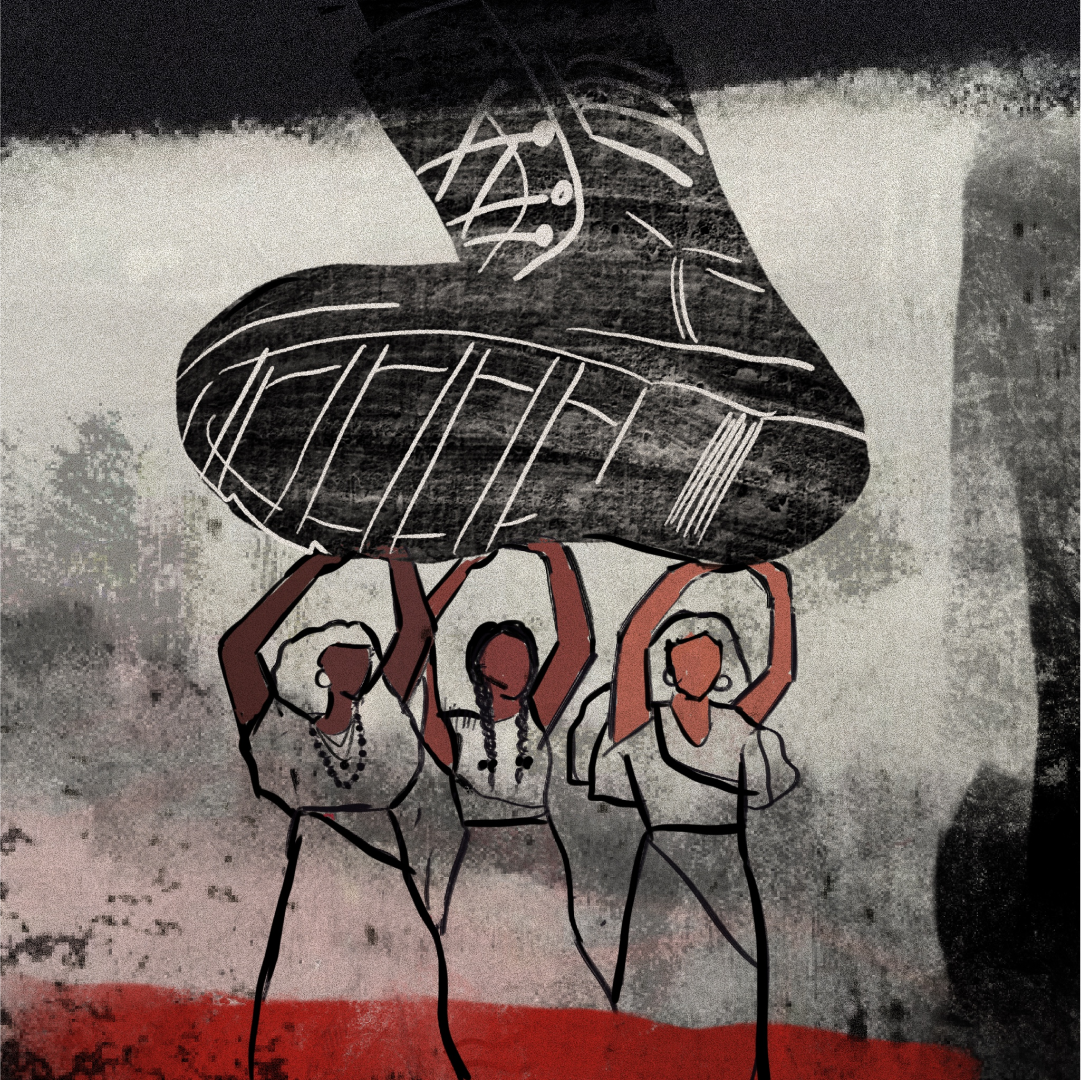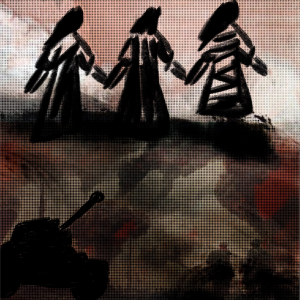Eastern Europe is home to the majority of an estimated 10-12 million Roma, half or close to half of whom are women, most of whom live in severe deprivation (EU Fundamental Rights Agency 2023; Blazevski et al. 2018; UNICEF Serbia 2020).
It is estimated that Roma men live 9.1 years shorter than the majority of men, while Roma women live 11 years shorter than the majority of women (ibid, 18), making Roma women a rare case of women living shorter than men globally.
During the last twenty years, the pan-European project “Decade of Roma Inclusion” was launched in 2000, and has aimed, among other things, to improve the position of Roma women (Brüggemann and Friedman 2017). The project is financially supported and designed by major international agents like the World Bank, the Council of Europe, different United Nations agencies, the Organization for Security and Co-operation in Europe, the World Health Organization, the Open Society Foundation, and others.
The design was created mainly by the donors under what can be called European colour-blind and developmental approaches. It was largely a top-down process, devoid of meaningful decision-making Roma engagement (Ryder et al. 2015). It adhered to the poverty alleviation policies traditionally applied to “Third World Countries”. While having a discourse on systemic inclusion, it was notably marked by the pervasive influence of unsustainable and expertise-driven, costly gadjo humanitarianism.
Plugging into the neoliberal market models, it was advancing the human capital paradigm, under which enhancing Roma competencies through education was frequently heralded as a panacea for ameliorating Roma exclusion and “breaking the cycle of poverty”. Out of several segments of intervention, including Roma employment, housing, health, political participation, etc., the most investment went into this field.
Under this project, Roma women, particularly the poor Roma women from slums, became a certain kind of subject, submitted to research, policies, and projects (Surdu and Kovats 2015; Selling 2018; Hancock 2008). Commonly regarded as the “double victims”, we are seen as discriminated against on the basis of ethnicity or racialized identity by the gadjo majority and based on gender by Roma men within Roma communities. Roma self-organizing predates the Decade of Roma Inclusion project, the establishment of the Gypsy Council, one of the first NGOs in the UK with a highly political profile often taken as a starting point (Andrew, Sarah, and Acton 2014).
Roma women as agents in Roma politics participating in the production of Roma women’s subjectivity appear, however, only later, closer to the end of the 90s. In most cases, as they are subjected to never-ending “capacity rising”, they continue to be gadjo “implementing partners”, unqualified executors of predefined donor agendas focusing on education, reproductive health, prevention of child marriages, some basic elements of advocacy, and in general, with limited participation in decision-making. During the last twenty years, a handful of Roma women established themselves and their organizations as partners with a higher level of access to consultation processes and, in some cases, also decision-making, and could become “Roma women of choice” for gadjo donors.
There is what we might call the European Roma elite today, which has some decision-making power, including mostly men but also some Roma women. The top-down and donor-defined Roma engagement, however, requires loyalty to the gadjo agendas and gadjo definitions of Roma subjectivity, needs, and politics, opening the space for different forms of entrepreneurship and clientelism (Rostas and Rövid 2015). As an element of this betrayal, within a broader context of the European Gadjo supremacy (Savić 2022a) and neoliberal setting as a suggested interpretative framework, I propose in reference to Fanon (2008) that Roma and especially Roma women are required to wear, “gadjo masks”, and engage in a competitive chase of “gadjo dragons” (Savić 2022b), setting the Roma women’s movement to fail due to not just racial but also gender and class betrayal, making Roma women’s solidarity close to impossible.
Gadjo masks and gadjo dragons
According to my definition, wearing a “gadjo mask” is a distressing process of self-inflicted dehumanization in which Roma are competitively striving to conform their thoughts, emotions, and behaviours to fit an idealized racist image of the idealized gadjo image of the Roma Other in different contexts, primarily with the purpose of survival. In the human rights industry, I have participated in different ways now for more than twenty years, considering the position of Roma women, gadjo interventions in their lives, especially the lives of poor Roma women, appear with immense and non-reflected power differences.
Interventions of gadjo donors often invested in humanitarian saviorism, in the spirit of “Game of Thrones” (Taylor et al. 2011) are akin to the appearance of the rulers riding on dragons’ backs, having close to divine status. As in some contexts empowered gadjo women are themselves called “dragon women”, I named this gadjo with immense power with respect to Roma “gadjo dragons”.
Roma men, but especially Roma women in the industry, are in a situation to chase these “gadjo dragons”, who might be interested in the Roma performance of wearing the “gadjo mask”. As every Roma entering civil society has an opportunity to learn, this ability to self-dehumanize is a valued currency in the gadjo human rights industry. Roma women find themselves in this “dragon’s nest” in this competition of wearing gadjo masks with other Roma women, all in pursuit of the acquisition of the status of the “Roma woman of choice”, who, except having the necessary knowledge and skills, is “cooperative” not a “difficult one”.
Even more preferably, a Roma woman might acquire the status of the enlightened “saving passion project”, which particularly gadjo feminists are fond of. Being a Roma woman subject of a particular kind, reflecting the ideal image of the “Great Roma saviour”, entitles the educated Roma woman to the divine intervention of the “gadjo dragon” in the life of an educated Roma woman, opening different doors in her life, just as in the life of a Roma woman from mahala.
While this economy of survival faces Roma men and women with the situation of required racial betrayal, this especially affects Roma women, dissolving their opportunities for organizing and solidarity. Due to the lack of gender sensibility among donors, Roma women are already forced into loyalty to men – the leaders of the Roma movement, having to opt for gender betrayal. For example, this was manifested in the attempts at political organizing in Serbia. In one election year, some Roma women within the Roma women’s network, gathering all Roma women’s civil society organizations, after the suggestion and agreement to start a Roma women’s party, at the last moment opted to enter into the parties led by Roma men, which affected the trust and internal dynamics of the network (Savić 2018). Next to other reasons, I believe this results in the almost complete disappearance of Roma women’s organizing and political participation today.
The neoliberal times
Another form of trade or betrayal in which Roma are required to engage is class betrayal. Being defined by the colour and class-blind political developmental agendas of the Global North entrenched in the history of colonialism and neoliberal market economy (Rodney and Davis 2018; Williams 1994; Robinson 2019; Rexhepi 2022; El-Tayeb 2011), Roma politics today is paradoxically sustaining gadjo racial (Mills 1997) as well as class contract, requiring from the “Roma of choice” that if they speak about racism and poverty, do so without disturbing the racial capitalist ground on which they stand (Robinson 2019). European investment in colourblind approaches to human rights relatively recently became challenged, making possible the idea of anti-Roma racism (Möschel 2011; Hellgren and Bereményi 2022; Matache and Bhabha 2020), although, on my account, race is in this case also approached more from an American than a post-colonial perspective.
Recently, what might be considered the leadership of the mainstream Roma movement made out of the selected “Talented Tenth” (F. C. Harris 2014) took a clear and sharp political turn towards neoliberal and market solutions for Roma poverty, while interestingly invoking the spirit of self-organizing before the time of donor politics, paradoxically based on socialist premises (Necula 2023). This modality of Roma politics holding to the human capital idea does not appeal anymore for human rights directly to the states but offers Roma as a young workforce, as a sustainable solution for the ageing European economy, and somewhat secondary underlines that Roma, with this gadjo interest in mind, might be deserving of a provision of their right to education, mostly vocational and applied one.
Far from humanistic ideals of education, which were closer to the socialist and post-socialist governments and times, it is a telling sign of the idea of Roma subjectivity reduced to the role of cheap labour in neoliberalism. Indeed, bearing in mind Fraser’s multiple models of critical theory, for Roma, knowing slavery and mostly living at the bottom of the 99% of the population, any wage might be a promise of emancipation, as, for many, paid exploitation represents an advance to their position (Fraser 2014).
Roma men making a political choice, taking the role of the middle-men serving the biggest of the “dragons”, prescribe “race to the bottom” in accordance with the rising neo-liberal European economic standard. It especially affects the post-socialist non-EU countries of the Western Balkans suffocating under foreign investment models, where there is no illusion even among better-off gadje about the promising possibilities of upward mobility while serving the European market. It should be noted that the favoured argument of Roma leaders, of course, lies on the gendered assumption of the high fertility rate.
The rate being in correlation with poverty and the lack of opportunities for Roma women makes the argument follow the well-elaborated and renewed conservative tendencies, being consequently based on the invisible reproductive labour of the poorest Roma women, the class of the “lowest of the low”, trapped by systemic oppression of patriarchy, racism, and poverty to produce young, workable, disposable Roma bodies sold to the European market.
As it shows, it is not just gadjo who expects the transition to neoliberalism to be paid for by the poor, in this case, to happen under emancipatory narratives “over this bridge called the poor Roma women’s back” (Moraga and Anzaldúa 1983).
While there are of course exceptions, this politics of redistribution and class betrayal of Roma men today seem to be seconded by the politics of a few Roma women who got some positions of power in the industry. There are not many, and they mostly occupy places in academia and in the domain of culture, covering the segment of cultural recognition and what, in a more traditional sense, might be seen as a superstructure producing consensus on the acceptance of neoliberal mainstream. One of the main strategies is the nurturing of cultural management focused on mainstreaming and respectability politics (F. C. Harris 2014).
The politics is complementary to the utilitarian commodification of human rights and, in its origin, presupposes controllable reasons for racism under the philosophy of racial self-help and improvement, with the hope that “respectable” decorum and demeanour can testify to the eligibility of racialized people to put up the demands for their rights, dignity, and pride (Higginbotham 1993, 195). This notion is certainly translatable to the class domain.
In attempts to distance themselves from the gadjo poverty-defined Roma subjectivity, the Roma elite tends to embrace elitism and poorism, as is after all prescribed by gadjo “Talented Tenth” design of the Decade of Roma Inclusion project.
Only one interesting example to consider, which I believe publicly announced in its plasticity the era of respectability politics, might be the photo exhibition of the Hungarian gadjo photographer Déri Miklós, called “Roma Body Politics – I. No innocent picture”, obviously embraced by Roma, being curated by Angéla Kóczé, Tímea Junghaus, Árpád Bak, more Roma participating as models, some of whom are considered to be Roma holding a critical stand (Déri Miklós 2015).
Here, in a self-proclaimed attempt to “uncover the colonial discourse inscribed in us” (ibid), which can also be read as class self-promotion, the better-off Roma present themselves in comparison to what is considered a stereotypical image of Roma, which they also take the liberty to perform. The imagined them, the impossible them, are in fact the underclass Roma, who are Othered by them, which I will call in reference to Combs (2022) the “bodies-out-of-Roma-place”, wearing their Roma identity as a false label, being without required class competency. With Roma’s identity being perhaps a false insignia, obviously, poor Roma are interlopers. As imagined outsiders within the Roma community, they are without an opportunity to explain their existence there, or to argue for their occupation of the space in this new Roma world, imagined and designed to fit the worldview and comfort of in fact better-off Roma, considering that there are no visible ethnic insignias, also rather mainstream, Gadjo-look-alike Roma.
The bodies marked by ethnicity, that is, poverty, are made suspect, as they break the gadjo and better off the Roma normative expectations. They are obviously an obstacle to acceptance to exclusive, dignified, “normal”, and in reference to “white wage”, referring to the benefits of the closeness to whiteness (W.E.B. Du Bois in C. I. Harris 1993, 285), as well “gadjo waged” Roma existence. In my reading, with an exclamation similar to “Look, a Negro” (Fanon 2008), there is “Look, a poor ‘Gypsy’ trespassing!”.
Those “Gypsies” are in fact, although imagined, captured, and dragged in the frame by Gadjo and the better-off Roma “art force” in the frame to be exposed to the meticulously elaborated “emancipatory” art design, and in a “spectacle of exclusion”, placated, disciplined, subjugated, I would also say inferiorized, delegitimized, and negated by being underclassed, vulgarized, uglified, buffonerized, infantilized, sexualized, criminalized, devalued, undesirable, and ashamed.
Considering the possibilities of solidarity among Roma women, the particular issue here is the treatment of the subjectivity of the poor Roma woman. While affirmative photographs mostly present Roma women as power-posing experts, their performed opposites are clearly marked with class-determined markings, standing as ethnic signifiers. In one of the photographs, a young Roma woman is with a child in her arms. It is interesting how the Roma woman’s body, with the testimony of reproduction in this photograph, is class-defined and pushed out of “respectable Roma space”.
On one possible reading, based on a class consensus, the better-off Roma women’s emancipatory, even feminist recognition politics aligns with the redistributive economic assumption of the better-off Roma men. The job of producing Roma bodies, Roma workers for the market is a poor Roma woman’s invisible job. Poor Roma women will be pushed away “behind the curtains” of “respectable” Roma politics and spaces, down the rapidly deepening class divide, towards the (re)production line, serving in the upward struggle of the “representable” Roma elite to attain equal status with gadje. While the work sharply carves the status stratification and operates on representations of class, social distancing, and shame, similar to the respectability politics of black Baptist women, it can also be seen as serving as a “bridge discourse” (Higginbotham 1993, 197), a silent language between the Roma elite and their intended gadjo audience of interest. Little is left to imagine the solidarity among Roma women on a class line when better-off Roma women found their interests converging with better-off Roma men and gadjo.
To conclude, I propose that in the context of the developmental and neoliberal donor-defined Roma human rights industry, Roma are required to wear “gadjo masks”, that is, to endure different forms of dehumanization while performing the prescribed role of the ideal Roma Other on competitive grounds. With this, they are to ensure the attention and “gadjo wages” conferred to them by gadjo with undeserved and disproportionate power to influence their lives, here called “gadjo dragons”.
My claim is that this setting predisposed Roma women initiatives that appeared in the last twenty years to failure through required race, gender, and especially class betrayal. Based on the political decision of Roma leaders, with more power to actually make them align with the neoliberal distribution politics and class consensus among better-off gadjo, Roma men, and Roma women, the class divide between Roma women is normalized and made wider through elitism and respectability politics.
The possibilities of solidarity among Roma women with this are rather marginal. In the time of neoliberalism, it is not unexpected for class to trump gender and race, although they are intersecting issues. The politics of solidarity among Roma women based on gender, race, and class would require feminist, anti-colonial, and leftist critical approaches questioning the premises of Roma identity politics in the last twenty years in a wider scope of the political economy of the Global North/West and acknowledgement of different kinds of privileges and acquired power positions among better-off Roma women creating the discourse and participating in the still-gadjo-defined and Roma men-dominated Roma movement.
_________________________
References
Andrew, Ryder, Cemlyn Sarah, and Thomas Acton, eds. 2014. Hearing the Voices of Gypsy, Roma and Traveller Communities: Inclusive Community Development. Bristol: Policy Press.
Blazevski, Nikica M., Sheila Marnie, and Ieva Keskine. 2018. The Position of Roma Women and Men in the Labour Markets of the Western Balkans: Micronarratives Report. UNDP. http://www.eurasia.undp.org/content/dam/rbec/docs/RomaEmployment_UNDP_RBEC.pdf.
Brüggemann, Christian, and Eben Friedman. 2017. “The Decade of Roma Inclusion: Origins, Actors, and Legacies.” European Education 49 (1): 1–9. https://doi.org/10.1080/10564934.2017.1290422.
Combs, Barbara H. 2022. Bodies out of Place: Theorizing Anti-Blackness in U.S. Society. Athens: University of Georgia Press.
Déri Miklós. 2015. Roma Body Politics. Photography. http://gallery8.org/romabody.
El-Tayeb, Fatima. 2011. European Others: Queering Ethnicity in Postnational Europe. Minneapolis: University of Minnesota Press. https://www.jstor.org/stable/10.5749/j.cttttbbx.
European Union Agency for Fundamental Rights. 2023. Roma in 10 European Countries, Roma Survey 2021 – Main Results. Vienna: European Union Agency for Fundamental Rights. https://fra.europa.eu/sites/default/files/fra_uploads/fra-2022-roma-survey-2021-main-results2_en.pdf.
Fanon, Frantz. 2008. Black Skin, White Masks. Translated by Charles L. Markmann. London: Pluto Press.
Fraser, Nancy. 2014. “Can Society Be Commodities All the Way down? Post-Polanyian Reflections on Capitalist Crisis.” Economy and Society 43 (4): 541–58. https://doi.org/10.1080/03085147.2014.898822.
Hancock, Ian. 2008. “The ‘Gipsy’ Stereotype and the Sexualization of Romani Women.” In “Gypsies” in European Literature and Culture, First Edition, 181–93. New York, NY: Palgrave Macmillan.
Harris, Cheryl I. 1993. “Whiteness as Property.” Harvard Law Review 106 (8): 1707–91. https://doi.org/10.2307/1341787.
Harris, Fredrick C. 2014. “The Rise of Respectability Politics.” Dissent 61 (1): 33–37. https://doi.org/10.1353/dss.2014.0010.
Hellgren, Zenia, and Bálint Ábel Bereményi, eds. 2022. Racialized Citizenship in Superdiverse Europe. Basel: MDPI – Multidisciplinary Digital Publishing Institute. https://doi.org/10.3390/books978-3-0365-3149-6.
Higginbotham, Evelyn B. 1993. Righteous Discontent: The Women’s Movement in the Black Baptist Church, 1880–1920. Cambridge, MA: Harvard University Press.
Matache, Margareta, and Jacqueline Bhabha. 2020. “Anti-Roma Racism Is Spiraling During COVID-19 Pandemic.” Health and Human Rights Journal (blog). April 8, 2020. https://www.hhrjournal.org/2020/04/anti-roma-racism-is-spiraling-during-covid-19-pandemic/.
Mills, Charles W. 1997. The Racial Contract. Ithaca: Cornell University Press.
Moraga, Cherríe, and Gloria Anzaldúa, eds. 1983. This Bridge Called My Back: Writings by Radical Women of Color. Second edition. New York: Kitchen Table, Women of Color Press.
Möschel, Mathias. 2011. “Race in Mainland European Legal Analysis: Towards a European Critical Race Theory.” Ethnic and Racial Studies 34 (10): 1648–64. https://doi.org/10.1080/01419870.2011.566623.
Necula, Ciprian. 2023. “Why Europe Needs Roma to Drive Its Economy.” Al Jazeera, May 22, 2023. https://www.aljazeera.com/opinions/2023/5/22/why-europe-needs-roma-to-drive-its-economy.
Rexhepi, Piro. 2022. White Enclosures: Racial Capitalism and Coloniality along the Balkan Route. Durham: Duke University Press Books.
Robinson, Cedric J. 2019. Cedric J. Robinson: On Racial Capitalism, Black Internationalism, and Cultures of Resistance. London: Pluto Press.
Rodney, Walter, and Angela Davis. 2018. How Europe Underdeveloped Africa. Brooklyn: Verso.
Rostas, Iulius, and Márton Rövid. 2015. “On Roma Civil Society, Roma Inclusion, and Roma Participation.” Roma Rights No 2 (January): 7–10.
Ryder, Andrew, Angela Kocze, Iulius Rostas, Jekaty-Erina Dunajeva, Marius Taba, Martin Rovid, Timea Junghaus, Keiran O’Reilly, and Marek Szilvasi, eds. 2015. Nothing About Us Without Us? Roma Participation in Policy Making and Knowledge Production, Speaking From the Margins. Budapest: European Roma Right Center. http://www.errc.org/uploads/upload_en/file/roma-rights-2-2015-nothing-about-us-without-us.pdf.
Savić, Jelena. 2018. “Romani Womens Movement in Serbia through Generations.” Belgrade. https://www.academia.edu/43717065/Romani_womens_movement_in_Serbia_through_generations.
———. 2022a. “Gadjo Privileges.” In . Vol. 5. 1. Soderton: Critical Romani Studies.
———. 2022b. “U Zmajičinom Gnezdu: Višestruka Diskriminacija Romskih Žena u Srbiji Unutar Konteksta Evropske Gadžovanske Supremacije [In the Nest of the She-Dragon: Multiple Discrimination of Roma Women in Serbia Within the Context of European Gadjo Supermatism].” Treća, Politike Promicanja Ljudskih Prava Danas XXV (1): 35–56.
Selling, Jan. 2018. “Assessing the Historical Irresponsibility of the Gypsy Lore Society in Light of Romani Subaltern Challenges.” Critical Romani Studies 1 (1): 44–61. https://doi.org/10.29098/crs.v1i1.15.
Surdu, Mihai, and Martin Kovats. 2015. “Roma Identity as an Expert-Political Construction.” Social Inclusion 3 (5): 5–18. https://doi.org/10.17645/si.v3i5.245.
UNICEF in Serbia. 2020. Serbia Multiple Indicator Cluster Survey 2019 and Serbia Roma Settlements Multiple Indicator Cluster Survey 2019. Translated by Marina Sretenović. Belgrade: Statistical Office of the Republic of Serbia and UNICEF. https://www.unicef.org/serbia/media/16726/file/MICS%206%20Multiple%20Indicator%20Cluster%20Survey%20for%202019.pdf.
Williams, Eric. 1994. Capitalism and Slavery. Richmond: University of North Carolina Press. https://www.jstor.org/stable/10.5149/9781469619491_williams.
__________________________
©
Disclaimer: “This publication has been produced with the support of Heinrich Böll Stiftung, Tirana Office. Its contents are the sole responsibility of the author and “Shota” magazine and do not necessarily reflect the views of the donor.”










